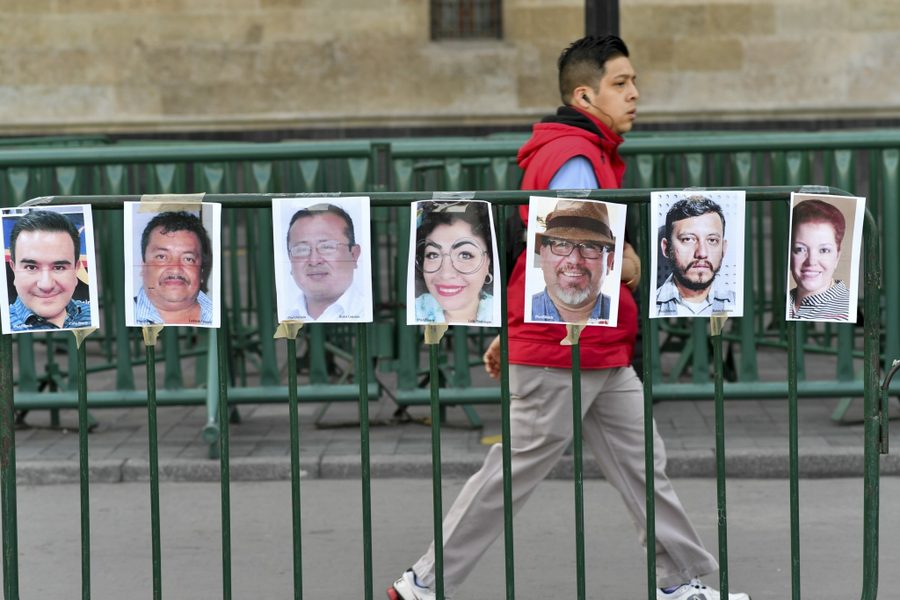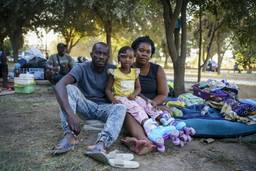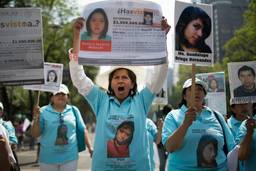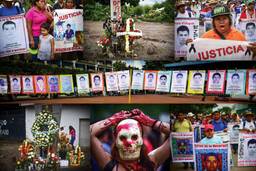Will the Mexican President-Elect’s “New Revolution” Include the Thousands of Disappeared?
Abandoned by the state, families are continuing the search for their missing loved ones. Andrés Manuel López Obrador has an opportunity to help.
Chantal Flores

On a hot day in May, a small group of mothers and fathers was sitting outside of a cemetery in Ciudad Miguel Alemán, Tamaulipas, just across Roma, Texas. They were waiting for dozens of forensic experts to exhume hundreds of unidentified bodies that were buried in common graves. While tarantulas circled their feet and a sticky humidity filled the air, they sat there for hours wondering if one of those bodies belong to their missing loved ones.
Meanwhile, a bit further south in Veracruz state, the Solecito Collective continued to wait for authorities to identify the nearly 300 bodies and thousands of human remains that were found in 2016 in what is now known as the largest mass grave in Mexico to date. Two years later, only 16 bodies have been identified.
“These are human lives that were lost in that place. It is not nothing. It’s not something superficial, something that can be omitted. This is something extremely serious that must be investigated. And no, they are not investigating anything,” says Lucy Díaz, co-founder of Solecito Collective and mother of Luis Guillermo Lagunes, who was disappeared in 2013.
On July 1, Andrés Manuel López Obrador won Mexico’s presidency, destroying a political duopoly and stirring hope in a country tha has seen more than 200,000 killed and 37,000 disappeared since 2006. With an electorate tired of political corruption and endemic violence, AMLO, as he’s popularly known, vowed to curb poverty, end corruption and bring peace to the country, though he has yet to present a detailed plan of action to achieve these lofty goals.
One of the main demands, which didn’t receive adequate attention from the presidential candidates during the campaigns, is the plight of the families of the disappeared, who are calling on lawmakers to respond to the continuing epidemic of enforced disappearances — and accelerate the search and identification of human remains. Between 2006 and 2017, according to the Mexican Commission for the Defense and Promotion of Human Rights, 1,588 hidden graves were found, with approximately 2,674 bodies and 11,429 human remains.
Lack of political will
After a person is disappeared in Mexico, the family faces an extensive journey of corruption, bureaucracy, impunity and the continuous criminalization of their loved ones. Exasperated by the state’s inaction, many of them have been forced to lead their own search efforts.
The General Law on Disappearances, which entered into force last year after a long delay, is the main legal mechanism to address the crisis. But collectives of relatives and human rights groups have stressed that without political will and resources, the new law, which mandates the creation of a new official registry of disappeared people and a national search commission, can’t be fully implemented.
“There are many things that have to happen to implement this law: give the national search commission the equipment and resources to begin the search for people, strengthen the PGR (Attorney General) so that it can investigate these cases, work with the families in the identification of remains,” explains Ximena Suárez-Enríquez, a Mexican lawyer who works with groups of victims, defenders and journalists, and is assistant director for Mexico of Washington Office on Latin America (WOLA).
“I think the biggest challenge is to ensure that there are institutions that can implement the law because that is the great challenge of Mexico sometimes. There are laws that are very good on paper, but in the implementation you realize that it has no resources to investigate or doesn’t have the will to investigate,” adds Suárez-Enríquez.
Understanding the violence
While high levels of impunity and systemic political corruption are key challenges for AMLO’s government, there is a bigger and more complex issue that is hiding under these deep-rooted problems: understanding the magnitude of Mexico’s severe human rights crisis.
“Not taking this seriously, or not understanding deeply the problem of violence in the country, can be a lost opportunity that could cost us a lot,” says Mónica Meltis, executive director of the citizen group Data Cívica, which uses data analysis to document human rights violations.
“I believe that within the challenges, it has the giant challenge of understanding the magnitude of the violence, of understanding the patterns of violence.”
Understanding size of the problem, as well as the multiplicity of forms of violence and heterogeneity of victims, is necessary to comprehend the grave human rights crisis, which also includes extrajudicial killings, femicides, torture, illegal detention and forced displacement, explains Guillermo Trejo, professor of Political Science at the University of Notre Dame.
Last year, Data Cívica revealed the names of the disappeared people listed on the government’s official registry in an effort to convert figures into people and start a process of “digital memory.” Families have often accused the government of underestimating the real figures of enforced disappearances and hidden graves, and failing to provide the necessary resources that the searches and processes of identification demand. Along with other human rights groups, Data Cívica is also currently working on a map to predict the localization of hidden graves in Mexico’s municipalities to aid the processes of truth and justice.
Beyond the hidden graves that may hold their disappeared loved ones, families have also been demanding the exhumation of unidentified bodies in common graves, such as in the case of Tamaulipas, which ranks first among states in Mexico for disappearances, with 6,131 victims. Unclaimed dead were buried without proper investigation as intense drug battles left piles of dead in the border state, a key spot in the drug and human smuggling routes.
Justice first
Graciela Pérez, who has been looking for her daughter, brother and three nephews since 2012, leads a collective that has been carrying out hundred of searches in southern Tamaulipas. Pérez claims that after the beginning of the exhumation project in Miguel Alemán, the first of its kind in the country, the support from authorities ceased due to limited resources.
“We don’t stop, we continue as a collective. We continue with the searches, we continue collecting [human remains], regardless of the authorities,” says Pérez.
Pérez and Díaz agree that their collectives won’t stop doing the most important work — looking for their loved ones— yet AMLO’s government has opened a window of opportunity and raised the hopes of victims of violence. Trejo, member of the Truth and Memory Group, a platform that unites victims with social organizations and academic groups, argues that the first step should be the creation of a national commission of truth, instead of the regional commissions that AMLO’s transition team has discussed. According to Trejo, the goals should be to dignify the victims, identify the perpetrators and understand the patterns and causes of the violence, following the principles of transitional justice.
While AMLO is not set to take office until December 1, he and his team have begun a series of peace and reconciliation forums where victims and experts are being consulted to develop a security proposal, which aims to address the root causes of violence. However, as is now common, the communication gap between victims and government officials widened as AMLO called to “forgive but not forget,” while families responded with a loud: “No forgiveness without justice.”
For the families, a truth-seeking process is mandatory to identify and reveal the fates of each of the thousands of disappeared, and bring those responsible to justice. They demand the new government end bureaucracy and corruption, implement the law, provide financial support to collectives of families with transparency and inclusion, bring authorities and collectives together to collaborate in search brigades and invest in genetic identification. Most importantly, they urge AMLO and his team to end the repeated rights violations that the State commits with total impunity.
“There is a lot of work to be done. The new government finds a country that today is destroyed in everything that refers to human rights, to human life. The subject of Mexico is human rights and the violations against them,” says Díaz. “But the priority will always be to find them”.







